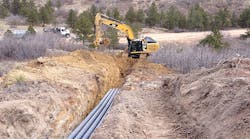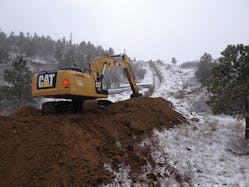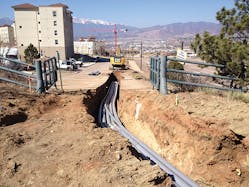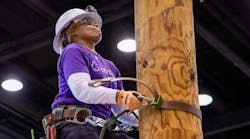To minimize outages and improve aesthetics, Colorado Springs Utilities linemen must install all new infrastructure underground within the city limits. At the same time, the field crews must maintain more than 1,000 miles of existing overhead infrastructure and, in some cases, work with customers to bury overhead lines.
The utility recently worked on an overhead-to-underground conversion to clear land for a new construction project at the University of Colorado at Colorado Springs. As part of the project, the linemen buried a section of overhead line to allow for the construction of new dorms and a 1,500-stall parking garage. Because the circuit was susceptible to lightning strikes, burying it underground was a win-win situation for both the university and the utility.
Clearing Land for New Construction
Prior to the construction project, an overhead line and three circuits came down a hill on the backside of the university. For many years, this land was unused green space, but the linemen had to bury the lines to make way for the new construction.
The portion of the overhead power line that was scheduled to be buried was tied into a substation and crossed many bluffs. Because of the uneven terrain, the field crews faced many challenges when installing the underground line. For example, the linemen were tasked with installing the underground line down a rough, narrow road.
To save a significant amount of time and material, the linemen chose not to follow the switchbacks on the mountain road. Instead, they worked with the engineers to map out a more efficient route for the underground line.
While it was extremely steep, the crew was able to rely on complicated rigging to run a backhoe down the side of the mountain. As an operator dug a 48-inch-deep ditch, the linemen put dirt on the level as he worked his way down.
Confronting Challenges
Working on the rugged, sloped terrain and the active college campus presented challenges to the Colorado Springs Utilities field crews. The crews took an outage over spring break so their construction work wouldn’t disrupt the students while the classes were in session or interfere with the flow of vehicular or pedestrian traffic on the campus.
Instead of just bulldozing the area behind the university and preparing the land to bury the underground line, the utility also had to contend with both environmental and archaeological restrictions. For example, the utility installed raptor protection, and the linemen had to take care not to disturb the nests while driving their equipment to the work site, digging trenches and placing pipes. In addition, they had to minimize the amount of dust created by the construction project by wetting down the dirt prior to placing it in the trench.
The land where the line crew was working also had archaeological significance. As such, each time the field crews dug in a particular spot, they had to wait while an archaeologist sifted through dirt looking for historical artifacts.
By working alongside environmental and historical teams, however, the line crew was able to successfully bury one of the most compromised overhead lines most heavily affected by lightning strikes while clearing space for the growing university.
Todd Shaffer ([email protected]) is a north district section leader for Colorado Springs Utilities, responsible for overseeing the line crews in the north district, planning out their weekly jobs and working with the inspector and quality control group. He has been with the company for 17 years.
Sidebar: How to Perform an Overhead to Underground Line Conversion
Burying overhead lines requires a significant amount of prep work and commitment on the coordination front. Here are 14 steps required to perform this process in the field.
1. Utility acquires the easement, the right-of-way and the proper environmental permits.
2. The field engineer then draws up the job.
3. The management team works with the customer to establish an approved time frame for the project and coordinate the work with the other contractors on the project.
4. The utility’s locating department helps to provide locates prior to the start of an underground job so linemen don’t dig into a fiber-optic line or storm drain.
5. Before constructing the underground line, the field crews must secure the proper equipment such as track hoes, dump trucks and front-end loaders.
6. When they’re ready to begin construction, the linemen dig a 4-ft to 5-ft trench with a track hoe.
7. The field crews then pull cable into the newly installed conduit.
8. The line crews then fill the trench with red-colored concrete and pour it directly on top of the pipe.
9. After encasing the pipe, the crews backfill the existing trench.
10. Every 750 ft of underground line, the linemen install a vault, and the linemen pull cable from one vault to the next. Then if they need to repair a certain section of cabling, they don’t have to take out the entire line.
11. The crews backfill the dirt and get compaction. To minimize the amount of dust on the job site, field crews should wet down the dirt before putting it back in place and compacting it. To do this, linemen can use a water truck and a roller truck.
12. The linemen work with the restoration crews to restore the land and make it look normal again, which can be very challenging in the sloped areas.
13. After the installation of the underground line is complete, the linemen energize the underground system.
14. The crews then take a planned outage to de-energize the existing overhead line and remove the overhead system.




